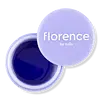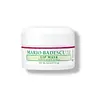What's inside
What's inside
 Key Ingredients
Key Ingredients

No key ingredients
 Benefits
Benefits

 Concerns
Concerns

 Ingredients Side-by-side
Ingredients Side-by-side

Octyldodecanol
EmollientEthylhexyl Palmitate
EmollientHydrogenated Polyisobutene
EmollientPolyglyceryl-3 Diisostearate
EmulsifyingEthylcellulose
Silica Silylate
EmollientPrunus Armeniaca Kernel Oil
MaskingWater
Skin ConditioningSqualane
EmollientHexylene Glycol
EmulsifyingRicinus Communis Seed Oil
MaskingCaprylyl Glycol
EmollientPhenoxyethanol
PreservativeParfum
MaskingCI 45410
Cosmetic ColorantCI 42090
Cosmetic Colorant1,2-Hexanediol
Skin ConditioningBis-Diglyceryl Polyacyladipate-2
EmollientButyrospermum Parkii Butter
Skin ConditioningCaprylyl Glycol
EmollientCarica Papaya Seed Oil
HumectantCarthamus Tinctorius Seed Oil
MaskingCocos Nucifera Fruit Extract
EmollientCocos Nucifera Oil
MaskingEuterpe Oleracea Fruit Oil
Skin ConditioningParfum
MaskingGlycine Soja Oil
EmollientHelianthus Annuus Seed Oil
EmollientHydrogenated Styrene/Isoprene Copolymer
Hydrogenated Polyisobutene
EmollientHydrogenated Styrene/Butadiene Copolymer
Microcrystalline Wax
Emulsion StabilisingPentaerythrityl Tetra-Di-T-Butyl Hydroxyhydrocinnamate
AntioxidantPolybutene
Sambucus Nigra Fruit Extract
AstringentSqualane
EmollientSucrose Tetrastearate Triacetate
EmollientSynthetic Wax
AbrasiveTetrahexyldecyl Ascorbate
AntioxidantTocopherol
AntioxidantVanilla Planifolia Fruit Extract
Skin Conditioning1,2-Hexanediol, Bis-Diglyceryl Polyacyladipate-2, Butyrospermum Parkii Butter, Caprylyl Glycol, Carica Papaya Seed Oil, Carthamus Tinctorius Seed Oil, Cocos Nucifera Fruit Extract, Cocos Nucifera Oil, Euterpe Oleracea Fruit Oil, Parfum, Glycine Soja Oil, Helianthus Annuus Seed Oil, Hydrogenated Styrene/Isoprene Copolymer, Hydrogenated Polyisobutene, Hydrogenated Styrene/Butadiene Copolymer, Microcrystalline Wax, Pentaerythrityl Tetra-Di-T-Butyl Hydroxyhydrocinnamate, Polybutene, Sambucus Nigra Fruit Extract, Squalane, Sucrose Tetrastearate Triacetate, Synthetic Wax, Tetrahexyldecyl Ascorbate, Tocopherol, Vanilla Planifolia Fruit Extract
Alternatives
Ingredients Explained
These ingredients are found in both products.
Ingredients higher up in an ingredient list are typically present in a larger amount.
Caprylyl Glycol is a humectant and emollient, meaning it attracts and preserves moisture.
It is a common ingredient in many products, especially those designed to hydrate skin. The primary benefits are retaining moisture, skin softening, and promoting a healthy skin barrier.
Though Caprylyl Glycol is an alcohol derived from fatty acids, it is not the kind that can dry out skin.
This ingredient is also used as a preservative to extend the life of products. It has slight antimicrobial properties.
Learn more about Caprylyl GlycolHydrogenated Polyisobutene is a synthetic polymer. Polymers are compounds with high molecular weight. Hydrogenated Polyisobutene is an emollient and texture enhancer.
In one study, Hydrogenated Polyisobutene showed better skin hydration levels than Caprylic/Capric Triglyceride. As an emollient, it helps keep your skin soft and hydrated by trapping moisture in.
Hydrogenated Polyisobutene is often used as a mineral oil replacement.
Learn more about Hydrogenated PolyisobuteneParfum is a catch-all term for an ingredient or more that is used to give a scent to products.
Also called "fragrance", this ingredient can be a blend of hundreds of chemicals or plant oils. This means every product with "fragrance" or "parfum" in the ingredients list is a different mixture.
For instance, Habanolide is a proprietary trade name for a specific aroma chemical. When used as a fragrance ingredient in cosmetics, most aroma chemicals fall under the broad labeling category of “FRAGRANCE” or “PARFUM” according to EU and US regulations.
The term 'parfum' or 'fragrance' is not regulated in many countries. In many cases, it is up to the brand to define this term.
For instance, many brands choose to label themselves as "fragrance-free" because they are not using synthetic fragrances. However, their products may still contain ingredients such as essential oils that are considered a fragrance by INCI standards.
One example is Calendula flower extract. Calendula is an essential oil that still imparts a scent or 'fragrance'.
Depending on the blend, the ingredients in the mixture can cause allergies and sensitivities on the skin. Some ingredients that are known EU allergens include linalool and citronellol.
Parfum can also be used to mask or cover an unpleasant scent.
The bottom line is: not all fragrances/parfum/ingredients are created equally. If you are worried about fragrances, we recommend taking a closer look at an ingredient. And of course, we always recommend speaking with a professional.
Learn more about ParfumSqualane is an emollient that helps the skin hold onto moisture. It's an oily liquid that occurs naturally in certain types of fish and plant oils.
Because squalane boosts hydration in the skin, it also comes with plenty of benefits: it is an antioxidant and can help fight free radicals and skin damage. Squalane is also found to have a detoxifying effect when applied.
Squalane comes from squalene, which occurs naturally within the sebum of our skin. It is one of the oils our skin produces to keep itself hydrated. Squalane is the hydrogenated version of squalene and has a longer shelf life.
Research shows that squalane is non-irritating (even at 100% concentration).
In general, it's a fantastic ingredient. It does a great job at hydrating the skin, and it's suitable for those with sensitive skin.
The source of squalane may impact malassezia / fungal acne. This is because olive oil derived squalane can contain impurities such as fatty acids and plant waxes. Sugarcane derived squalane is recommended for anyone with malassezia concerns.
Is squalane vegan?
This depends on the source. Squalane can be derived from both plants and animals. Most squalane used in skincare comes from plants.
Please note: the source of squalane is only known if disclosed by the brand. We recommend reaching out to the brand if you have any questions about their squalane.
Read more about squalene with an "e".
Is squalane an oil?
Squalane is often called an oil, but it’s technically not; it’s a hydrocarbon, meaning it’s only made of carbon and hydrogen, unlike true oils which are triglycerides made of fatty acids and glycerol.
The term “oil-free” isn’t regulated, so companies can define it however they want. Some exclude all oils, while others just avoid mineral oil or comedogenic oils.
While some people avoid oils thinking they cause breakouts, the right kind of oil (or oil-like ingredient like squalane) can actually help balance and hydrate your skin. It’s worth testing out simple oils or squalane to see what works best for your skin.
Learn more about Squalane